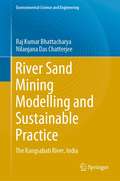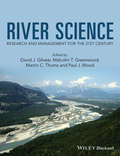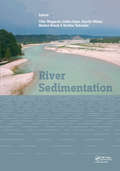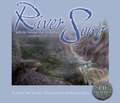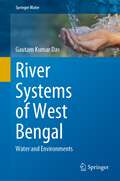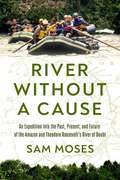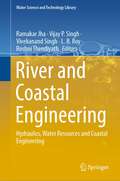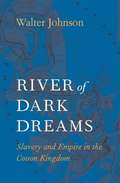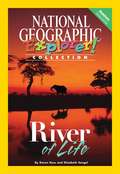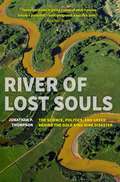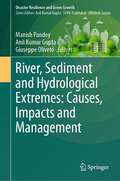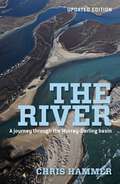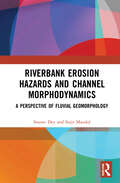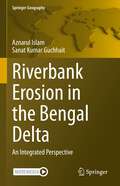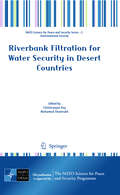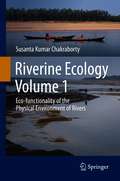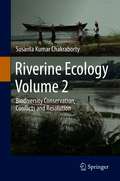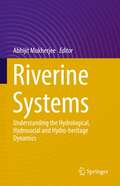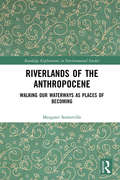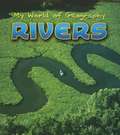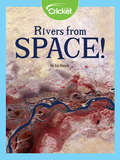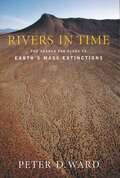- Table View
- List View
River Sand Mining Modelling and Sustainable Practice: The Kangsabati River, India (Environmental Science and Engineering)
by Nilanjana Das Chatterjee Raj Kumar BhattacharyaWorldwide demand for sand and gravel is increasing daily, as the need for these materials continues to rise, for example in the construction sector, in land filling and for transportation sector based infrastructural projects. This results in over-extraction of sand from channel beds, and hampers the natural renewal of sediment, geological setup and morphological processes of the riverine system. In India, illegal sand mining (of alluvial channels) and gravel mining (of perennial channels) are two anthropogenic issues that negatively affect the sustainable drainage system. Along the Kangsabati River in India, the consequences of sand mining are very serious. The construction of Mukutmonipur Dam (1958) on the river causes huge sediment deposition along the middle and downstream areas, these same areas are also intensely mined for sand (instream and on the flood plain). Geospatial models are applied in order to better understand the state and the resilience of stream hydraulics, morphological and river ecosystem variables during pre-mining and post-mining stages, using micro-level datasets of the Kangsabati River. The book also includes practicable measures to minimize the environmental consequences of instream mining in respect to optimum sand mining. It discusses the threshold limits of each variable in stream hydraulics, morphological and river ecological regime, and also discusses the most affected variables. Consequently, all outputs will be very useful for students, researchers, academicians, decision makers and practitioners and will facilitate applying these techniques to create models for other river basins.
River Science: Research and Management for the 21st Century
by David J. Gilvear Malcolm T. Greenwood Martin C. Thoms Paul J WoodRiver Science is a rapidly developing interdisciplinary field at the interface of the natural sciences, engineering and socio-political sciences. It recognises that the sustainable management of contemporary rivers will increasingly require new ways of characterising them to enable engagement with the diverse range of stakeholders.This volume represents the outcome of research by many of the authors and their colleagues over the last 40 years and demonstrates the integral role that River Science now plays in underpinning our understanding of the functioning of natural ecosystems, and how societal demands and historic changes have affected these systems. The book will inform academics, policy makers and society in general of the benefits of healthy functioning riverine systems, and will increase awareness of the wide range of ecosystem goods and services they provide.
River Sedimentation: Proceedings of the 13th International Symposium on River Sedimentation (Stuttgart, Germany, 19-22 September, 2016)
by Silke Wieprecht Stefan Haun Karolin Weber Markus Noack Kristina TerheidenSediment dynamics in fluvial systems is of great ecological, economic and human-health-related significance worldwide. Appropriate management strategies are therefore needed to limit maintenance costs as well as minimize potential hazards to the aquatic and adjacent environments. Human intervention, ranging from nutrient/pollutant release to physical modifications, has a large impact on sediment quantity and quality and thus on river morphology as well as on ecological functioning. Truly understanding sediment dynamics requires as a consequence a multidisciplinary approach.River Sedimentation contains the peer-reviewed scientific contributions presented at the 13th International Symposium on River Sedimentation (ISRS 2016, Stuttgart, Germany, 19-22 September 2016), and includes recent accomplishments in theoretical developments, numerical modelling, experimental laboratory work, field investigations and monitoring as well as management methodologies.
River Song with The Banana Slug String Band
by Steve Van ZandtA river is a wonderful thing, from the trickle of snowmelt to the ocean, and from icy winter through a warm autumn--and is celebrated in this volume through illustrations, verse and a song by a popular children's band.
River Systems of West Bengal: Water and Environments (Springer Water)
by Gautam Kumar DasThe book explains the basic concepts of river water quality index, river environments, shifting of river courses, dams and barrages – their merits and demerits, mutual interdependence of river and society etc. in the typical geomorphic set up of West Bengal. In India, West Bengal is a riverine state due to the towering Himalayas to the north and the Bay of Bengal to the south. In between the mountain and sea, due to the location of the Gangetic delta region and its stability with space and time, the rivers of this state are gradually dying. In addition to the stability of the delta, the river channel is being filled with sediments carried along the river course from upstream. The role of dams, barrages and reservoirs in the normal flow of rivers at different geographical locations deserves discussion which is included in the book. It is to be expected that the rivers of West Bengal can be an outstanding example of mutual interdependence of science and society, all of which are included in the book.The use of different physicochemical parameters adopted for the water quality index of different rivers described in this book will provide new directions in this regard. With discussions like water quality index, river environments, shifting of river courses, reservoirs, dams and barrages, and mutual interdependence of river and society, it is the intention that this book, River Systems of West Bengal - Water and Environments, will be useful for the research and higher studies in the river related field. This book will be of interest to students and researchers of riverine environments.
River Without a Cause: An Expedition through the Past, Present and Future of Theodore Roosevelt's River of Doubt
by Sam MosesA riveting journey down Theodore Roosevelt's "river of doubt" with a diverse crew of adventurers, scientists, and Indigenous leaders who shine light on the past, present, and future of a natural wonder.Sam Moses took part in the adventure of a lifetime when he, along with seventeen men and two women, embarked on the Rio Roosevelt Expedition. They would follow the former president's wake down five-hundred miles of extreme whitewater into the dark heart of the Amazon. The party was guided by two chiefs from the Cinta Larga tribe—the same tribe that stalked Roosevelt&’s expedition in 1914—who, between rapids, tell the story of the tribe&’s own Trail of Tears. After the wildest whitewater is past, Moses travels with the chiefs to their village to witness the massive illegal mahogany logging from their forest, the Roosevelt Indigenous Territory. River Without a Cause puts us in the raft during those heart pounding rapid descents, as we experience the drama, dynamics and disputes between the Bull Moose and his co-leader, Brazil&’s most famous explorer, the rigid Colonel Candido Rondon. As the Amazon stands on the precipiece of hope with the election of a new Brazillian president, River Without a Cause is a moving and galvanzing tale of adventure that is a fitting tribute to this world wonder.
River and Coastal Engineering: Hydraulics, Water Resources and Coastal Engineering (Water Science and Technology Library #117)
by Vijay P. Singh Ramakar Jha Vivekanand Singh L. B. Roy Roshni ThendiyathThis book deals with important topics of current interest, such as climate change, floods, drought, and hydrological extremes. The impact of climate change on water resources is drawing worldwide attention in these days; water resources in many countries are already stressed and climate change along with burgeoning population, rising standard of living, and increasing demand are adding to the stress. Further, river basins are becoming less resilient to climatic vagaries. Fundamental to addressing these issues is hydrological modelling which is covered in these books. Further, integrated water resources management is vital to ensure water and food security. Integral to the management is groundwater and solute transport. The books encompass tools that will be useful to mitigate the adverse consequences of natural disasters. This book is useful for those working in river and coastal engineering. River Engineering is important for fluvial hydraulics, sediment transport, morphometry, desilting, trap efficiency, silting and desilting process. Coastal engineering includes storm surge forecast, optimization of harbour, wave modelling, and shoreline changes.
River of Dark Dreams: Slavery and Empire in the Cotton Kingdom
by Walter JohnsonRiver of Dark Dreams places the Cotton Kingdom at the center of worldwide webs of exchange and exploitation that extended across oceans and drove an insatiable hunger for new lands. This bold reaccounting dramatically alters our understanding of American slavery and its role in U. S. expansionism, global capitalism, and the upcoming Civil War.
River of Dust: The Life-Giving Link Between North Africa and the Amazon
by Jilanne HoffmannOver and Under the Rainforest meets This Is How We Do It in A River of Dust—a celebration of global interconnectedness with an environmental lens, at a time when we need it most.I am dust,the dust of North Africa.I connect continents. The dust of the Sahel—a ribbon of land between the Sahara and the savannah—lifts with the harmattan wind each winter season. But this is not just any dust. The Sahel's dust will mix with dust from the Sahara and travel thousands of miles westward, across the African continent and the Atlantic Ocean, to reunite with its unforgotten home deep in the Amazon basin. Told in the perspective of dust, A River of Dust takes readers on a journey through vibrantly illustrated landscapes, celebrating the power and wonder of Earth's ecosystems, and showing how these tiny particles are in fact key to the health of our planet. Meticulously researched and lushly illustrated, this picture book is a lyrical ode to global interconnectedness and the vital roles that even the smallest play in taking care of our planet.GLOBAL CONNECTIVITY: Just like This Is How We Do It, this book emphasizes global connectivity: the Amazon can't succeed by itself, and we all have a role to play.SMALL PARTICLES, MIGHTY IMPACT: This powerful story of the Sahel's very necessary contribution to the world demonstrates how seemingly inconsequential particles are key to the health of our planet. And if dust can be so important, readers will imagine the impact each one of them can have on the world around them.EDUCATIONAL TOOL: With strong STEM themes, this offers plenty of opportunities to incorporate into lesson plans, from units on geography and environmental science, particularly lessons on the rainforest, global warming, and interconnected ecosystems.SOOTHING LULLABY: Poetic and yearning, this picture book has a gentle message that reassures its readers about remaining connected despite time and distance with an affirmation of love that parents will enjoy sharing with their children.ARTFUL & LUSH: Vivid landscapes, from the deserts of Africa to the rainforests of the Amazon, by illustrator Eugenia Mello, make this lyrical picture book come to life. Note the gorgeous spattering of foil dust on the jacket, which makes this cover glow!WANT TO LEARN MORE?: Meticulously researched information included at the back of the book provides insight and compelling scientific facts for readers who are curious to know more. Did you know that there are more trees in the Amazon than stars in the Milky Way galaxy?Perfect for:Resource for teachers and librarians seeking books about nature, the earth, and ecology for kidsParents looking for non-fiction picture books and science books for childrenA beautiful environmental picture book and lyrical story for anyone interested in learning about ecosystems and the environmentFans of Over and Under the Rainforest, Over and Under the Pond, and other popular nature books for young readers
River of Life
by Debbie S. MillerAs the seasons change, a river in Alaska reveals its remarkable biodiversity. A great web of life is presented--the river and its shores sustain an astonishing variety of plants and animals. The river is home: salmon fry and rainbow trout live in it, plankton drifts in its current. The river is food: bears and bald eagles catch salmon, big fish chase little fish, tree roots absorb the river water. This evocative nonfiction picture book follows a year in the life of this Alaskan river. The lyrical text and lush paintings introduce young readers to the sights and sounds of the river and its inhabitants and are rich in details certain to fascinate ecologists of all ages.
River of Lost Souls: The Science, Politics, and Greed behind the Gold King Mine Disaster
by Jonathan ThompsonAward–winning investigative environmental journalist Jonathan P. Thompson digs into the science, politics, and greed behind the 2015 Gold King Mine disaster, and unearths a litany of impacts wrought by a century and a half of mining, energy development, and fracking in southwestern Colorado. Amid these harsh realities, Thompson explores how a new generation is setting out to make amends. <p><p> As shocking and heartbreaking as the Gold King spill and its aftermath may be, it's merely the tip of the proverbial iceberg. The disaster itself was the climax of the long and troubled story of the Gold King mine, staked by a Swedish immigrant back in 1887. And it was only the most visible manifestation of a slow–moving, multi–faceted environmental catastrophe that had been unfolding here long before the events of August 5, 2015.
River, Sediment and Hydrological Extremes: Causes, Impacts and Management (Disaster Resilience and Green Growth)
by Anil Kumar Gupta Manish Pandey Giuseppe OlivetoThis edited book provides a platform for knowledge sharing in all areas related to the rivers, sediment and hydrological extremes. It explains the hypothesis that river flow and sediment transport are intimately linked to erosion, scour and sediment deposition. Sediment transport, erosion and deposition are driven by local base-level changes and are highly variable in space and time. These concepts have serious implication for understanding the recent development of the River, Sediment and Hydrological Extremes.The natural hazards posed by hydrologic events and river systems depend on the uncertainty of hydrological events. This ability is affected by change in climatic conditions. Climate change studies have revealed that the frequency of extreme weather phenomena with increasing damage to human assets has gradually grown worldwide. As a consequence, rainfall events concentrated in time and space are expected to lead to serious local flooding and sediment transport in many parts of the world. Floods are remarkable hydro-meteorological phenomena and forceful agents of geomorphic evolution in most physical geographical belts and, from the viewpoint of human society, among the most important environmental hazards. According to the Indian Environment Agency, floods rank as number one on the list of natural disasters in India over the past decade.This book is an attempt to fill the gap in literature and bring forth evidence based latest research about precise estimation of erosion and scour, which is essential to reduce the hazards. The book explains that lack of preparedness and appropriate adaptation strategy makes people more risk-prone. It highlights the vulnerability in South Asia region about the impacts of flood, sediments, and river hazards because a large portion of its population depends on sensitive sectors like agriculture and forestry for livelihoods and several other reasons.The book is relevant for academician, researchers and students of disaster management, hydrology and ecology.
River: A Journey Through The Murray-Darling Basin
by Chris HammerIn The River, Chris Hammer takes us on a journey through Australia's heartland, following the rivers of the Murray-Darling Basin, recounting his experiences, his impressions, and, above all, stories of the people he meets along the way. It's a journey punctuated with laughter, sadness and reflection. The River looks past the daily news reports and their sterile statistics, revealing the true impact of our rivers' decline on the people who live along their shores, and on the country as a whole. It's a tale that leaves the reader with a lingering sense of nostalgia for an Australia that may be fading away forever.
Riverbank Erosion Hazards and Channel Morphodynamics: A Perspective of Fluvial Geomorphology
by Sujit Mandal Sourav DeyThis book explores fluvial processes and their consequences on river dynamics in India. It discusses the integration of geomorphic, hydrologic, and socio-economic data with various policies and decisions regarding sustainable river basin management. The volume looks at the origin and development of streams, chronology of fluvial geomorphology, fluvial system concept, process–form interaction, river dynamics, channel migration, flow regime, channel types, and hydraulic and morphometric parameters; and explains how changing hydro-geomorphological dynamics have influenced land use patterns, nature of fluids, behaviour of floods, etc. It examines channel migration vulnerability and bank erosion hazard vulnerability of the Torsa River in the eastern region of India as a case study using channel migration zone and Bank Erosion Hazard Index models. The book presents a new research framework based on field surveys, scientific investigations, and analytical techniques and methods to interpret key geoinformatics data. With its extensive illustrations, this book will be useful to students, teachers, and researchers of geography, earth sciences, environmental geology, and environment and disaster management. It will also interest geographers, civil engineers, hydrologists, geomorphologists, planners, and other individuals and organizations working on fluvial processes and riverbank erosion problems globally.
Riverbank Erosion in the Bengal Delta: An Integrated Perspective (Springer Geography)
by Aznarul Islam Sanat Kumar GuchhaitThis book discusses the issue of riverbank erosion and its associated causes, risks and social challenges in the Bengal Delta. The book covers the physical processes and indicators of riverbank erosion such as sediment flux and channel morphology, the anthropogenic and natural causes of erosion, the social consequences that afflict vulnerable communities who depend on the delta for their livelihoods, and potential solutions to harmful erosion processes such as bioengineering methods and increased community governance through a socio-hydrological approach. Though the Bengal Delta is one of the most populated regions in the world, few publications exist that discuss riverbank erosion as a major threat to environmental and livelihood sustainability in a comprehensive manner. The book will fill this gap in research for students and researchers in geography and environmental sciences, and will engage regional planners, decision makers and policy makers to further their understanding of the complex social and environmental aspects of the Bengal Delta associated with persistent and worsening riverbank erosion.
Riverbank Filtration for Water Security in Desert Countries
by Chittaranjan Ray Mohamed ShamrukhRiverbank filtration is a low cost, yet efficient water treatment technology. It has most potential to provide safe drinking water to large cities located along rivers or lakes. In particular, it is ideal for large population centres in developing countries, where the cost of building extensive treatment facilities is prohibitive. Water filtration can be successfully implemented using naturally occurring sand and gravel along the river/lake banks. The cost of water produced by this means is much lower than that of water treated in conventional treatment plants. Authored by a multi-disciplinary team of experts, this volume addresses the scientific basis of the filtration process, and also numerous topics of importance for the planning, technical realization, and security of such plants. Their application for the removal of relevant chemical pollutants and a variety of pathogens is analysed in detail.
Riverine Ecology Volume 1: Eco-functionality of the Physical Environment of Rivers
by Susanta Kumar ChakrabortyThis book is part of a two-volume set that offers an innovative approach towards developing methods and tools for assigning conservation categories of threatened taxa and their conservation strategies by way of different phases of eco-restoration in the context of freshwater river systems of tropical bio-geographic zones. The set provides a considerable volume of research on the biodiversity component of river ecosystems, seasonal dynamics of physical chemical parameters, geo-hydrological properties, types, sources and modes of action of different types of pollution, river restoration strategies and methodologies for the ongoing ecological changes of river ecosystems. Volume 1 provides an in-depth analysis of different theories with international relevance pertaining to the functioning of river ecosystems, shaping their structure and contributing ecological services, and includes the principles of riverine ecology such as biogeochemical cycles, physiography, hydrogeology, and physico-chemical parameters. It covers the basic concepts and principles of water within riverine ecosystems, and the underlying ecological principles operating to ensure ecological stability and sustainability of the fluvial ecosystem. The book explains the ecofunctionality of different geo-morphological, geo-hydrological and physico-chemical factors and processes in changing time scales and spaces, with special emphasis on the tropical fresh water rivers in India.
Riverine Ecology Volume 2: Biodiversity Conservation, Conflicts and Resolution
by Susanta Kumar ChakrabortyThis book is part of a two-volume set that offers an innovative approach towards developing methods and tools for assigning conservation categories of threatened taxa and their conservation strategies by way of different phases of eco-restoration in the context of freshwater river systems of tropical bio-geographic zones. The set provides a considerable volume of research on the biodiversity component of river ecosystems, seasonal dynamics of physical chemical parameters, geo-hydrological properties, types, sources and modes of action of different types of pollution, river restoration strategies and methodologies for the ongoing ecological changes of river ecosystems.Volume 2 highlights biodiversity potential in aiding the resistance and resilience of riverine ecosystem functioning and their synergistic effects on ongoing environmental perturbations. Comprehensive information on the conservation of river-associated-wildlife is provided, covering the impacts of pollution, land-use changes, river policies, and ecosystem restoration strategies. The book offers an innovative approach towards developing methods and tools for assigning conservation categories of threatened taxa, and covers their conservation strategies by way of different phases of eco-restoration in the context of freshwater river systems of tropical bio-geographic zones.
Riverine Systems: Understanding the Hydrological, Hydrosocial and Hydro-heritage Dynamics
by Abhijit MukherjeeThis book provides a unique opportunity to integrate the knowledge on regional-scale riverine reviews to local-scale case-studies, ranging from availability to pollution, national-level river management to transboundary governance. It is an unparalleled attempt to build the bridge between the science of rivers and its history and socio-politics, thus articulating the due credence of rivers from ancient civilizations to modern human societies. The chapters in this book are organized by the sub-sections of i) Hydrology, ii) Hydrosocial and iii) Hydro-heritage, thus providing a unique knowledge on the river studies for historians, scientists, planners, social scientists and policymakers, and are written by leading experts and researchers from across the globe.
Riverlands of the Anthropocene: Walking Our Waterways as Places of Becoming (Routledge Explorations in Environmental Studies)
by Margaret SomervilleThis is an invitation to readers to ponder universal questions about human relations with rivers and water for the precarious times of the Anthropocene. The book asks how humans can learn through sensory embodied encounters with local waterways that shape the architecture of cities and make global connections with environments everywhere. The book considers human becomings with urban waterways to address some of the major conceptual challenges of the Anthropocene, through stories of trauma and healing, environmental activism, and encounters with the living beings that inhabit waterways. Its unique contribution is to bring together Australian Aboriginal knowledges with contemporary western, new materialist, posthuman and Deleuzean philosophies, foregrounding how visual, creative and artistic forms can assist us in thinking beyond the constraints of western thought to enable other modes of being and knowing the world for an unpredictable future. Riverlands of the Anthropocene will be of particular interest to those studying the Anthropocene through the lenses of environmental humanities, environmental education, philosophy, ecofeminism and cultural studies.
Rivers (My World of Geography)
by Angela RoystonWhat is the source of a river? How can you travel on a river? How can you help protect rivers? Read this book to find out all about rivers!
Rivers from Space!
by Liz HuyckWhen on land, rivers, lakes, and oceans appear flat. With the aid of satellites, these bodies of water appear to have many designs! Explore the art of nature and how satellites detect the temperature of the many bodies of water around the globe.
Rivers in Time
by Peter D. WardSeveral times in the distant past, catastrophic extinctions have swept the Earth, causing more than half of all species―from single-celled organisms to awe-inspiring behemoths―to suddenly vanish and be replaced by new life forms. Today the rich diversity of life on the Earth is again in grave danger―and the cause is not a sudden cataclysmic event but rather humankind's devastation of the environment. Is life on our planet teetering on the brink of another mass extinction? In this absorbing new book, acclaimed paleontologist Peter D. Ward answers this daunting question with a resounding yes. Elaborating on and updating Ward's previous work, The End of Evolution, Rivers in Time delves into his newest discoveries. The book presents the gripping tale of the author's investigations into the history of life and death on Earth through a series of expeditions that have brought him ever closer to the truth about mass extinctions, past and future. First describing the three previous mass extinctions―those marking the transition from the Permian to the Triassic periods 245 million years ago, the Triassic to the Jurassic 200 million years ago, and the Cretaceous to the Tertiary 65 million years ago―Ward assesses the present devastation in which countless species are coming to the end of their evolution at the hand of that wandering, potentially destructive force called Homo sapiens. The book takes readers to the Philippine Sea, now eerily empty of life, where only a few decades of catching fish by using dynamite have resulted in eviscerated coral reefs―and a dramatic reduction in the marine life the region can support. Ward travels to Canada's Queen Charlotte Islands to investigate the extinctions that mark the boundary between the Triassic and Jurassic periods. He ventures also into the Karoo desert of southern Africa, where some of Earth's earliest land life emerged from the water and stood poised to develop into mammal form, only to be obliterated during the Permian/Triassic extinction. Rivers of Time provides reason to marvel and mourn, to fear and hope, as it bears stark witness to the urgency of the Earth's present predicament: Ward offers powerful proof that if radical measures are not taken to protect the biodiversity of this planet, much of life as we know it may not survive.
Rivers in the Landscape: Science And Management
by Ellen WohlRivers are the great shapers of terrestrial landscapes. Very few points on Earth above sea level do not lie within a drainage basin. Even points distant from the nearest channel are likely to be influenced by that channel. Tectonic uplift raises rock thousands of meters above sea level. Precipitation falling on the uplifted terrain concentrates into channels that carry sediment downward to the oceans and influence the steepness of adjacent hill slopes by governing the rate at which the landscape incises. Rivers migrate laterally across lowlands, creating a complex topography of terraces, floodplain wetlands and channels. Subtle differences in elevation, grain size, and soil moisture across this topography control the movement of ground water and the distribution of plants and animals. Rivers in the Landscape, Second Edition, emphasizes general principles and conceptual models, as well as concrete examples of each topic drawn from the extensive literature on river process and form. The book is suitable for use as a course text or a general reference on rivers. Aimed at advanced undergraduate students, graduate students, and professionals looking for a concise summary of physical aspects of rivers, Rivers in the Landscape is designed to: emphasize the connectivity between rivers and the greater landscape by explicitly considering the interactions between rivers and tectonics, climate, biota, and human activities; provide a concise summary of the current state of knowledge for physical process and form in rivers; reflect the diversity of river environments, from mountainous, headwater channels to large, lowland, floodplain rivers and from the arctic to the tropics; reflect the diverse methods that scientists use to characterize and understand river process and form, including remote sensing, field measurements, physical experiments, and numerical simulations; reflect the increasing emphasis on quantification in fluvial geomorphology and the study of Earth surfaces in general; provide both an introduction to the classic, foundational papers on each topic, and a guide to the latest, particularly insightful and integrative references.
